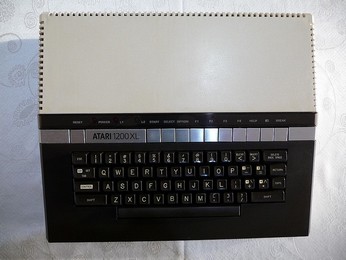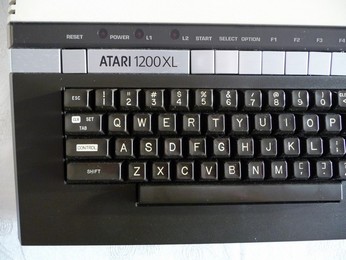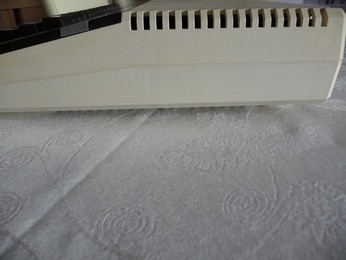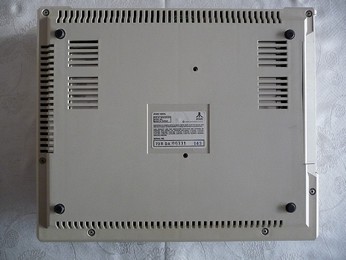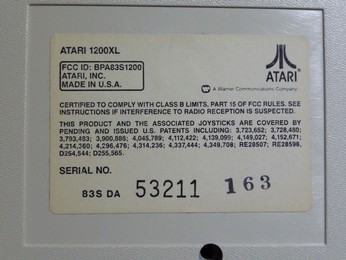NTSC/PAL/SECAM & PERITEL?
If you do not know what these acronyms refer to, please read the "NTSC/PAL/SECAM/PERITEL" article in the knowledge base first.
The computer
Although it was produced only for a few months in 1983, the Atari 1200XL is common in the USA. Some sources{1}, based on serial numbers, estimate that it is likely that just over 110,000 units Atari 1200XLs were manufactured (+ 250 "pilot" units in fall 1982).
{1} "1200XL Owners Club (serial tracker)" from AtariAge.org
Still, it remains much more difficult to acquire for European collectors like me simply because it was never sold outside the USA.
The 1200XL has some unique features, found only on this model. For instance:
-
Two LEDs labelled L1 and L2, just above the keyboard. They are normally off.
L1 lights up when the keyboard is disabled.
L2 lights up when the new International Character Set is selected.
Note: the L1 and L2 LEDs were also present in the 1450XLD computer, which was never released and remained as prototype.
-
Four function keys labelled F1 to F4.
Note: the four function keys were also present in the 1400XL and 1450XLD computers, which were never released and remained as prototypes.
Nowadays, I am still amazed by the timeless modern look of the XL series. An Atari XL (800XL) was recently included in a French auction of 2,000 objects with iconic design, ranging from Dieter Rams (for Braun) to Le Corbusier (who was credited for a radio set).
Made in
I am very lucky — for a European Atari collector — to own several 1200XL, including a model made in the USA and another model made in Taiwan.
The connectors
The superb Atari rainbow logo on boot up
For me it was not a waste of time, but a demonstration of power. I regret that this boot screen has been removed from subsequent versions of the OS.
For the video: Altirra emulator, Atari 800XL, PAL, 1983 OS Rev. 2, running the 1200XL rainbow boot screen code in loop.
The new embedded "Self-Test" program
The "Self-Test" which will be an integral part of the OS on all subsequent machines first appeared with the Atari 1200XL. Please read the "Self-Test" article in the knowledge base for all details.
The keyboard test allows you to test the function keys F1 to F4 (introduced with the 1200XL). These keys will be physically removed from the 600XL and 800XL onwards but the "Self-Test" keyboard test will not be updated immediately, offering to test keys that no longer existed...
On the 1200XL, the RAM test will cause the L1 and L2 LEDs above the keyboard to flash alternately. As the 1200XL is the only model equipped with these L1 and L2 LEDs, this specificity will disappear with the 600XL & 800XL.
Also, on the 1200XL, Scott Stilphen mentioned in the FAQ (section: "What is the Atari 1200XL?") that if you select "All tests", when it gets to the keyboard test it'll type out the programmer's name: Michael Colburn. The updated version removes this name and types in some letters that don't mean anything.
The memory test is particularly long on the 1200XL. Skip to 4:40 to see the rest.
For the video: Altirra emulator, Atari 1200XL, NTSC, 1982 OS Rev. 10 (aka Rev. A), running the "Self-Test".
Rev. 10 & Rev. 11 OS ROMs
Rev. 10 (aka Rev. A): The vast majority of Atari 1200XLs in circulation today are equipped with the original OS, Rev. 10 (aka Rev. A).
Very quickly, Atari discovered that this first revision posed a number of problems, particularly in the following clearly identified cases{2}:
- Its major problem is incompatibility with a lot of non-Atari applications which violated good programming practice — including some Atari programs, too.
➥ Solved in Rev. 11 (aka Rev. B)? No.
➥ To mitigate this issue, Atari developed Translator{3} programs that loaded the Atari 800 OS into the 1200XL. - Included in this list of incompatible programs were 40 or so cassette titles sold through the Atari Program Exchange (APX) whose auto-boot header program made improper assumptions about the OS environment which Rev. 10 (aka Rev. A) did not support. This problem has been addressed by releasing the Rev. 11 (aka Rev. B) OS, and by re-mastering the cassettes using an auto-boot program written to follow the proper rules.
➥ Solved in Rev. 11 (aka Rev. B)? Yes - The RESET key is supported by Rev. 10 (aka Rev. A) as being connected either to the ANTIC reset input or to the 6502 reset. Unlike its predecessors, the 1200XL and subsequent computers attach RESET to the 6502 reset line and no longer to the ANTIC reset input line. It was found that the circuitry for the RESET key had electronic or mechanical bounce problems. It shows itself by intermittently causing a cold rather than a warm start. In other words, once in a while, pressing the RESET key would not simply reset the computer as expected but, instead, would be the equivalent of turning the computer off and on again, hence losing all the content of the RAM memory…
➥ Solved in Rev. 11 (aka Rev. B)? Yes
{2} Please read the following documents in the Rare Atari documents section for all the details: BKUP-19XX-XX-XX-MANU-0001A-B; Atari Home computer operating system usage guidelines.
{3} Please read the "XL/XE Translators" article in the knowledge base for all details.
Rev. 11 (aka Rev. B): Like Rev. 10 (aka Rev. A), this OS is for the Atari 1200XL computer only. It was released almost immediately after Rev. 10 (aka Rev. A). Its major purpose was to provide bypasses for the problems with the bad APX cassette tape programs. Additionally, some other small problems were corrected — including the RESET sometimes causing a cold start issue. Unfortunately, the short production life of the 1200XL has caused far more Rev. 10's than Rev. 11's to have been shipped.
Which one do I have?
According to Atari documents "Tech tip #18 (12 July 1983)" & "Tech tip #18A (29 Sept 1983)", 3 versions of ROMs containing the Operating System were installed in the 1200XLs:
- Rev. 10 (aka Rev. A), EPROMs — very first 1200XLs manufactured.
- Rev. 10 (aka Rev. A), ROMs — the overwhelming majority of 1200XLs.
- Rev. 11 (aka Rev. B), ROMs — probably the 1200XLs that have been serviced. It has not yet been proven that some Atari 1200XL have been sold directly with OS Rev. 11 (aka Rev. B) installed as standard in the production plant.
If you have the Rev. 10 (aka Rev. A) version on EPROMs, or the Rev. 11 (aka Rev. B), your 1200XL is a rare model.
Technical problems
Problems that can be solved
If your 1200XL encounters one of the following problems, please consult the Atari "Tech tip" documents to solve it:
- The screen distorts with high intensity (black to white) screens. Characters appear to be very wavy, torn or ghost images, and the video on the screen seems to enlarge. The source of this problem has been clearly identified: an error of assessment by an engineer (also identified). The problem is due to a miscalculation of the values of the composite video and luminance resistors.
- The audio is of poor quality or does not exist at all. The audio must be constantly readjusted or cannot be adjusted.
- No picture when the Star Raiders cartridge is powered up
Problems that cannot be solved
Atari has also identified some hardware problems in the 1200XL that have been fixed either in later models (Atari 600XL/Atari 800XL), or some software problems that have been fixed in OSes later than Rev. 11 (aka Rev. B) — i.e. not for the 1200XL:
- In BASIC, pressing the BREAK key while performing a
LISTis intermittantly ignored. - In BASIC, if a program makes a CIO call to floppy disk drive #2 (or higher) immediately prior to a CIO printer request, the print request will fail.
Is the Atari 1200XL a good computer?
The Atari 1200XL is an excellent computer. Fans particularly appreciate its wonderful keyboard feel. In my opinion, the best keyboard of all Atari 8-bit computers. Its elegant design is timeless. The animated Atari logo at start-up is something Atari should have kept on later models.
On the negative side, it lacks a parallel port (PBI/ECI), which now deprives it of some very interesting extensions.
PEEK identification
Using "PEEK" instructions in BASIC to find out about the OS, Basic and NTSC/PAL versions.
For your information, the results are:
PEEK(53268) = 15 [NTSC]
PEEK(65528) = 191 [Not a 400/800]
PEEK(65527) = 10 [XL OS Rev. 10 (aka Rev. A), 1982-10-26, 1200XL (most)]
PEEK(43234) = 162 [Atari BASIC Rev. A, in external cartridge]
Video signals output
Here is a summary of the video signals available on this particular model.
To be able to use one of these video signals to display an image, you obviously need to check that your TV or video monitor has an input for the specific video signal you intend to use. If it doesn't have it, the easiest thing to do is to use a modern video converter/upscaler to convert the video signal available to you to HDMI, for example.
| Video signal | Available on | Remark |
|---|---|---|
| NTSC RF Antenna | RCA, TV aerial plug | |
| NTSC Video Composite aka CVBS | DIN, Monitor socket | |
| NTSC Y Only, aka Luminance only | DIN, Monitor socket | No C, Chroma in this socket |
Special thanks to Jerome Delsarte for all this information and his expertise on video signals.
